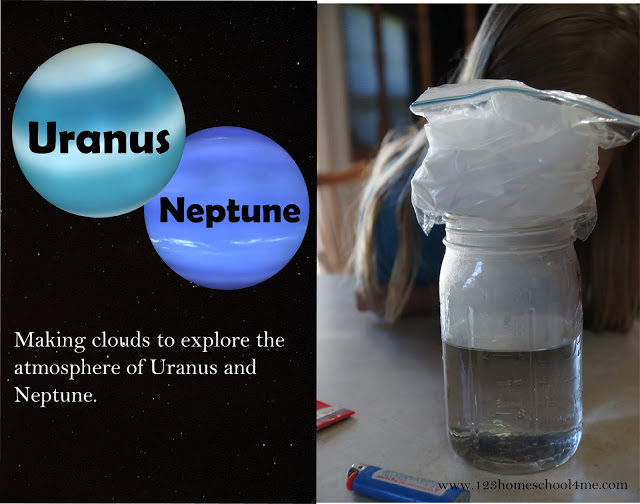We are continuing on in our solar system unit.
We've talked about the sun , inner planets, and now we are ready to start learning about the last four planets, the gaseous outer planets - Jupiter, Saturn, Uranus, and Neptune.
This is a really fun, hands on unit to help kids learn while having fun.
Solar System Unit - Outer Planets
Jupiter
Jupiter is the first of the outer planets and is the biggest planet in our solar system. It is known as a gas giant because it is made up mostly of gases - hydrogen and helium. Although the swirly patterns are pretty to look at, they are actually clouds indicative of very story skies including the Great Red Spot with a hurricane type storm that travels around the planet for the last 300 years.
We also learned that Jupiter has rings too, rotates quickly, has more than 60 satellites (or moons), and the spacecraft Galileo.
Hurricane Science Experiment
To help us remember The Great Red Spot on Jupiter that is like a hurricane on earth we made a classic science project- a hurricane in a bottle.
Saturn
Saturn is the most famous planet in our solar system with it's beautiful, recognizable rings. It actually has thousands of rings made up of dust, ice, and rocks orbiting the planet
We also learned Saturn is almost like Jupiter's twin - both gaseous planets with hydrogen and helium and more than 30 moons each. Saturn's beauty is also due to the clouds and violent storms on the planet with 1,000 miles an hour winds.
In studying about Saturn we learned about the Cassini Mission (see more) - unmanned spacecraft sent to explore the planet and its moons. It is taller than a 2-story building and needed the help of a powerful rocket to lift it off the ground into outer space.
Rocket Science Experiment for Kids
We made our own rockets to explore how chemical reactions can launch a rocket. You will need plastic film canisters (get them here for cheap), Alka Seltzer tablets, and creativity.
Hint: We found the rockets launched the best with less weight. So although building a cardboard tube or plastic bottle rocket is fun..... consider just a piece or regular paper wrapped around the tube for a better launch. The kids liked launching just the film canisters for an impressive 2-3 story height.
Fill a canister with with about 1 TAB warm water (note cap will be the bottom of your rocket). When ready to launch open lid and add 1/2 Alka Seltzer tablet and quickly put back on the lid and place on ground. Countdown to rocket launch . . .
Curious about the science behind the rocket launch? The Alka Seltzer mixed with water causing a chemical reaction where gases are created. Because the canister has only so much space once there is no more room for the growing number of gasses the pressure will make it launch. In case you are wondering, using more Alka Selter will not cause it to go higher. The amount of gas or pressure in the canister will be the same, but because there is more of the reactor it will happen quicker so step back quicker as the launch will happen sooner, but the height will be the same. For a higher launch you'll need to find a larger container.
Uranus
Uranus is a large gas giant with not only hydrogen and helium, but methane gases too (which gives it the blue color). Interestingly, this planet is lying down -the North/South poles are horizontal and therefore its rings go around the planet instead of through it.
Another face we found interesting was that this planet was actually discovered by homeschoolers - William & Caroline Herschel in 1781.
To make clouds in a jar all you need is a large jar half filled with warm water, a bag of ice, and a match. Light the match and toss it in the jar and quickly cover with bag of ice.
Kids will be amazed by the clouds that form.
Neptune
Neptune is a twin plant to Uranus. It also is a gas giant with hydrogen, helium, and methane gas making it look blue. After the discover of Uranus scientist suspected there was another planet because of the gravitational pull on Uranus; they finally found Neptune in 1846.
Neptune has a Great Dark Spot (like Jupiter's red spot) that is a powerful storm. But unlike storms on earth where we have water rain down, scientists believe based on the methane that diamond dust forms int he storm and falls from the clouds.
One of it's moons, Triton is a whopping - 400 F and is filled with geysers. However since there is no water it most likely spews a mixture of chemicals.
Plus for every planet we studied the kids took notes on things they learned that were interesting using these free solar system worksheets for kids.
















